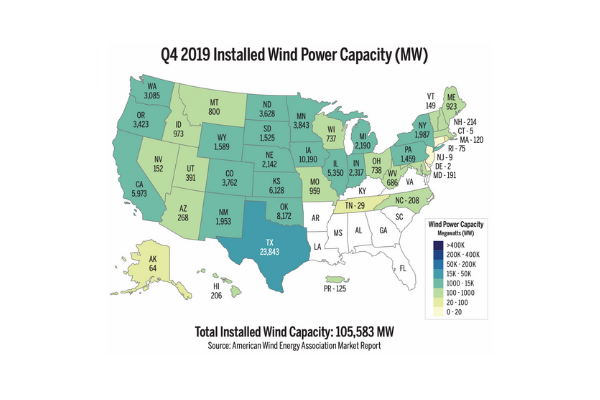OKLAHOMA CITY – A settlement agreement approved recently by the Oklahoma Corporation Commission ensures the Sooner State will continue to be a leader in
commercial wind power “while keeping its position as one of the lowest-cost states for electricity,” the agency announced.
The agreement allows Public Service Co. of Oklahoma (PSO) to recover its expenses associated with adding 675 megawatts (MW) of wind power, but without imposing any rate increase because cost savings result- ing from the project will be passed on to customers.
If the four-state project receives the blessing of regulators in all four (Texas, Arkansas, Louisiana, and Oklahoma), and from the Federal Energy Regulatory Commission, savings for customers of PSO and its affiliate Southwestern Electric Power Co. (SWEPCO) are projected to total $1.42 billion over the 31year life of the project.
PSO serves more than three dozen cities and towns in southwest Oklahoma.
PSO, SWEPCO WANT TO PURCHASE 3 OKLAHOMA WIND FARMS
PSO and SWEPCO want to spend $2 billion to buy three wind farms totaling 1,485 megawatts that are under construction across parts of seven Oklahoma counties (Alfalfa, Blaine, Custer, Garfield, Kingfisher, Major, and Woods). PSO’s investment in the projects will be $908 million, said Stan Whiteford, the company’s communications manager.
The projects include a 999- MW facility (named “Traverse”) being built north of Weatherford, a 287-MW facility (“Maverick”) being built southwest of Enid, and a 199- MW wind farm (“Sundance”) under construction south of Alva near Cleo Springs.
The smallest wind farm, Sundance, will consist of 72 wind turbines and is expected to be completed by the end of this year, Whiteford said. Maverick will have 103 turbines and Traverse will have 359 turbines, he said; those two wind farms are expected to be completed by the end of 2021. The entire project is expected to be fully operational by early 2022.
All three wind farms are being developed by Invenergy, a power generation developer based in Chicago, Ill.
SWEPCO will own 810 MW of the wind generation or approximately 54.5% of the projects, and PSO will own 675 MW, or almost 45.5%. The two sister companies are subsidiaries of American Electric Power (AEP).
The three projects will generate more than 5.7 million megawatt hours of wind energy annually for customers in the four states.
One megawatt is equal to 1,000 kilowatts. Although usage varies widely, the “typical” PSO residential customer uses about 1,100 kilowatt hours (kWh) of electricity per month, Whiteford said.
SAVINGS ANTICIPATED FROM TAX CREDITS, USE OF WIND. SOLAR
PSO contends that initially, the new assets will achieve savings from federal production tax credits the utility expects to receive for acquiring its share of ownership in the three wind farms.
Customers will subsequently benefit via reduced costs of generating electricity from wind rather than from coal or natural gas. The utility is reducing its appetite for coal and increasing its reliance on renewable wind and solar power, AEP President, Chairman and CEO Nicholas Akins said.
Wind power already produces 22% of the energy PSO delivers to its customers, Whiteford said. When the trio of new wind farms go online, wind power will generate 34% of the energy PSO delivers, he said.
Electricity generation from coal constitutes only 17% of PSO’s energy mix, Whiteford said, and that percentage is declining. PSO owns 15% of a coal-fired power plant at Vernon, Texas, which will be shuttered in October, and the company’s only other coal-fired plant, at Oologah, will be retired in 2026, he said.
PSO, based in Tulsa, says it supplies electricity to more than 550,000 customers in southwestern and eastern Oklahoma. Its service territory in southwest Oklahoma includes Altus, Apache, Arapaho, Blair, Burns Flat, Cache, Carnegie, Cement, Cyril, Davidson, Duke, Duncan, Elgin, Elmer, Fletcher, Fort Cobb, Gotebo, Gould, Grandfield, Granite, Hobart, Hollis, Humphreys, Lawton, Lone Wolf, Manitou, Martha, Mountain Park, Mountain View, Roosevelt, Rush Springs, Snyder, Sterling, Temple, Terral, Tipton, and Waurika.
WIND FARMS TO CREATE JOBS, GENERATE TAXES
PSO claims that 3,800 jobs could potentially be created in the seven counties during construction of the three wind farms.
The three new wind energy projects are projected to pay approximately $680 million in ad valorem taxes over their 30-year operational life.
• More than $450 million would go directly to local school districts.
• Nearly $34 million would go to county schools via the 4-mill fund allocation process.
• $58 million would be earmarked for CareerTech school districts.
• More than $135 million would be routed to county treasuries for general county services, county health departments, libraries, and other county activities.
PSO is one of the largest property taxpayers in Oklahoma; its ad valorem tax bill in 2018 was nearly $40 million.
PROJECT COST CAP, OFF-SYSTEM SALES TO BENEFIT CUSTOMERS
The agreement endorsed by the Corporation Commission “addresses key concerns,” Commissioner Bob Anthony said. The arrangement “includes ratepayer protections such as a cost cap guarantee and off-system sales” to other users of the electric grid, which will benefit PSO customers.
According to the U.S. Energy Information Administration, the average retail price of electricity in Oklahoma in 2018 (the latest year for which statistics are available) was 8.09 cents per kilowatt hour, 48th lowest in the nation. The Sooner State’s average electricity cost ranked 49th in the nation in 2017, the EIA reported.
The three new Oklahoma wind farms will add 1,485 megawatts of total capacity to an electric grid in the Great Plains operated by the Southwest Power Pool (SPP), which is headquartered in Little Rock, Ark.
SPP oversees the bulk electric grid and wholesale power market in the central United States on behalf of a diverse group of utilities and transmission companies that serve 14 states (Oklahoma, Arkansas, Iowa, Kansas, Louisiana, Minnesota, Missouri, Montana, Nebraska, New Mexico, North and South Dakota, Texas, and Wyoming).
The 546,000-square-mile region has more than 60,000 miles of high-voltage transmission lines, according to the SPP.


